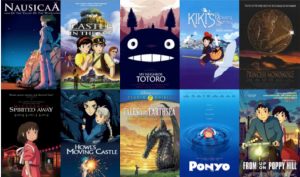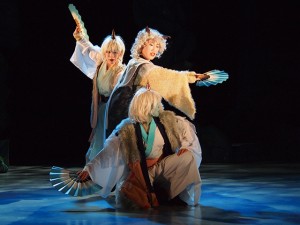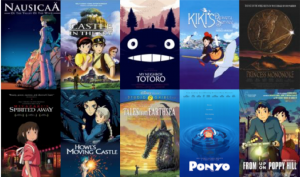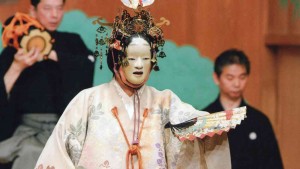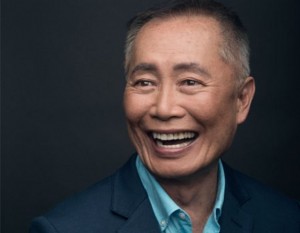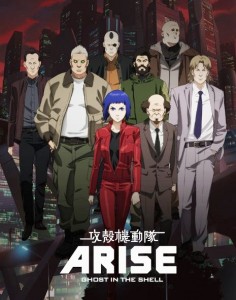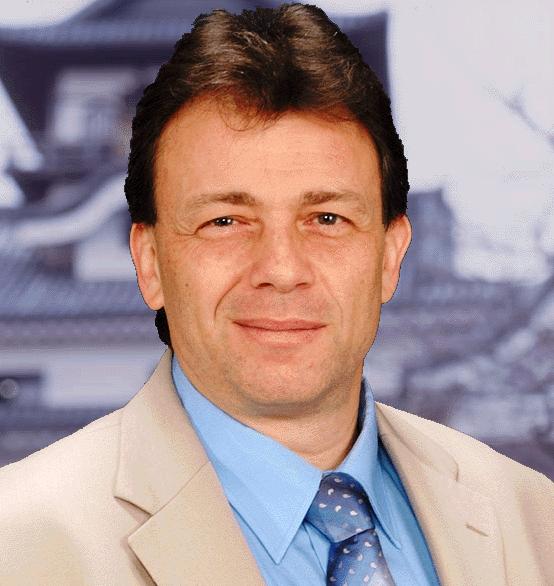JQ Magazine: Nippon in New York — Studio Ghibli, Asa Akira, Liberty City Anime Con, Sekai no Owari
By JQ magazine editor Justin Tedaldi (CIR Kobe-shi, 2001-02). Justin has written about Japanese arts and entertainment for JETAA since 2005. For more of his articles, click here.
In the dog days of summer, it’s best to escape the heat in a place that’s cozy and cool. For those into Japanese cultural events, this month offers a diverse selection of film premieres and live music—all in the comfort of indoor air conditioning.
This month’s highlights include:
Various dates from Aug. 3
Village East Cinema, 181-189 Second Avenue
$10, $15
This month, Village East Cinema presents four more films from the legendary Studio Ghibli and Academy Award-winning director Hayao Miyazaki! Here’s your chance to enjoy some Japan’s greatest and most influential animated films on the big screen. The morning screenings are English dubbed versions, while the evening screenings are in Japanese with English subtitles. This month’s selections include Japan’s all-time box office champ Spirited Away (Aug. 3-4), Howl’s Moving Castle (Aug. 10-11), Tales from Earthsea (Aug. 17-18), and From Up on Poppy Hill (Aug. 31-Sept. 1).
Tuesday, Aug. 9, 2016
Asa Akira, Dirty Thirty
$12.99 Kindle, $13.64 paperback
The world knows her as a porn star…but it’s her way with words that will touch you again and again. As she contemplates turning thirty years old while still being in the adult film trade, Asa Akira delves into her past, present, and future, exploring the events that brought her to where she is now and the surprising and insightful plans she has for her future. Asa’s perceptive, funny, and straightforward writings on love, sex, death, marriage and celebrity come together in this surprising book of essays that will have you laughing hysterically one minute and deep in reverent thought the next. Personally revealing as well as universal, Dirty Thirty marks the coming of age of a new literary star.
Aug. 12-17
Flamboyán Theater at The Clemente, 107 Suffolk Street
$13-$18
OZmate, a musical theater company based in Takarazuka, proudly presents The Legend of Oni with an all-female cast as part of the New York International Fringe Festival (FringeNYC)! The Legend of Oni is a musical about two Oni, ogres in Japan, in the pre-samurai Heian period. Lose yourself in the beautiful Japanese days of old with wonderful kimono costumes under the direction of Naoko Tsujii. OZmate also appears earlier this month as part of J-Summit New York at the Bowery Electric (327 Bowery) on Sunday, Aug. 7, with additional performances by Truthseekers, LUST, Lulla LayLa, Tamuro Rie, Naoki, Megumi, Shino Frances, Takaro Nishimura, and Emi Matsushita. Doors open at 5:30 p.m.; tickets are $15 advance, $18 at the door (includes one drink).
JQ Magazine: Nippon in New York — Studio Ghibli, JAPAN CUTS, Hotei, ‘Takarazuka CHICAGO,’ Kyary Pamyu Pamyu
By JQ magazine editor Justin Tedaldi (CIR Kobe-shi, 2001-02). Visit his Examiner.com Japanese culture page here for related stories.
After you’ve seen the outdoor fireworks, enjoy some summer events in the cool indoors, whether it’s catching one of the dozens films premiering at Japan Society’s annual festival, or enjoying anything from traditional theater to the latest pop sensation.
This month’s highlights include:
Various dates beginning July 6
Village East Cinema, 181-189 Second Avenue
$10, $15
This month, Village East Cinema presents four films from the legendary Studio Ghibli and Academy Award-winning director Hayao Miyazaki! Every Wednesday and Thursday from July 6 through July 28 offers a chance to enjoy some Japan’s greatest and most influential animated films on the big screen. The morning screenings are English dubbed versions, while the evening screenings are in Japanese with English subtitles. July’s selections include Castle in the Sky, My Neighbor Totoro, Kiki’s Delivery Service, and Princess Mononoke.
July 13-17
Rose Theater, Broadway at West 60th Street, 5F
$30-$125
In the enigmatic Japanese dramas of Noh, ancient stories from classical Japanese literature and oral traditions come to life in a sublime, ritualized blend of poetry, music, drama, and dance. The divide between the natural and supernatural is bridged as spirits and humans interact in a world rife with symbolism. The nearly 700-year-old dramatic form—known to many for its highly stylized masks and elegantly simple set featuring a single pine tree—is one of the world’s oldest continuously performed genres of performance art and was recently designated an “Intangible Cultural Heritage” by UNESCO. Kiyokazu Kanze—the 26th Grand Master of the Kanze School and a descendent of the founder of Noh—brings the profound lyricism and aesthetic elegance of this ancient dramatic art form to New York as part of this year’s Lincoln Center Festival. A special lecture and demonstration by Kiyokazu Kanze will be held July 12 at Japan Society; click here for more info and tickets.
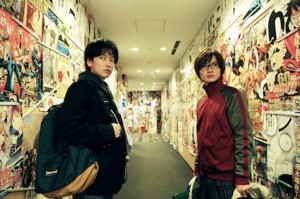
‘Bakuman’ © 2015 TOHO Amuse DENTSU SHUEISHA Victor KDDI GYAO Crescendo NIPPAN JR Kikaku LINE © Tsugumi Oba, Takeshi Obata SHUEISHA All Rights Reserved.
July 14-24
Japan Society, 333 East 47th Street
$10-$20 (single screenings)
North America’s largest festival of new Japanese film returns for its 10th anniversary edition, offering eleven days of impossible-to-see-anywhere-else screenings of the best new movies made in and around Japan with special guest filmmakers and stars, post-screening Q&As, parties, giveaways and much more. With special guests such as Lily Franky, Atsuko Maeda and Sion Sono, this year’s festival guest list is the largest in history, and includes directors, stars, producers and more. Make sure to also check out this year’s expanded DOCUMENTARY FOCUS and EXPERIMENTAL SPOTLIGHT sections. Venture out of the mainstream to discover new work by some of Japan’s most vital and interesting nonfiction and avant-garde practitioners. The experimental lineup is dedicated to animation, offering vibrant short-form alternatives to the ubiquitous anime for which Japan is so famous.
JQ Magazine: Carnegie Hall Hosts ‘Grand Japan Theater’
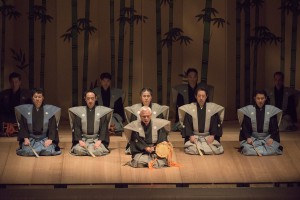
The noh portion of the evening featured Living National Treasure Kamei Tadao: “For those who attended, this was a once-in-a-lifetime experience, which fulfilled the promise of Japanese performing arts that made many of us fall in love with the culture in the first place.” (Masahito Ono)
By Vlad Baranenko (Saitama-ken, 2000-02) for JQ magazine. Vlad is an avid photographer.
On March 1, Carnegie Hall’s Stern Auditorium hosted Grand Japan Theater (also billed as An Evening of Japanese Traditional Theatre), which presented New York City with a spectacular rare performance of kyogen, noh and kabuki—all in one night. After kicking off their international tour in Tokyo and Osaka, then traveling halfway across the globe to introduce the first ever kabuki/noh performance to the royal family of Fujairah in the United Arab Emirates, the troupe finally arrived in the U.S. for one special night.
A sold-out crowd of over 2,800 witnessed some of the biggest names in traditional Japanese theater, including the noh otsuzumi artist Kamei Tadao, who in 2002 was designated as a Living National Treasure; the internationally renowned kabuki and television actor Ichikawa Ebizo XI, who began his career at just six years old and has evolved into one of the most versatile traditional actors today; and many more with direct roots to these beautiful centuries-old art forms.
The backdrop for all of the evening’s performances featured three sets of traditional Japanese screens adorned with illustrations of bamboo that blended perfectly into the background despite the enormity of the hall. The night’s program began with the kyogen piece Sanbaso. (Kyogen, an art form that almost always accompanies a noh performance and acts as a short, often comical “intermission piece” for the audience, has traditionally been based on a Shinto religious rite that prays for peace, fertility and prosperity across the land.)
JQ Magazine: New York Pledges Allegiance to George Takei at Japan Society

George Takei (right), with moderator Kermit Roosevelt at Japan Society, New York, Jan. 2016. (Ann Chow)
By Lyle Sylvander (Yokohama-shi, 2001-02) for JQ magazine. Lyle has completed a master’s program at the School of International and Public Affairs at Columbia University and has been writing for the JET Alumni Association of New York since 2004. He is also the goalkeeper for FC Japan, a New York City-based soccer team.
On Jan. 25, George Takei participated in a talk at Japan Society in New York. Best known for playing the role of Sulu on the original Star Trek and its movie incarnations, Takei has embarked on a second career as a social rights activist. Takei’s childhood in a pair United States internment camps for people of Japanese descent during World War II provided the focus for the conversation (entitled From Barbed Wire to Broadway), which was moderated by Kermit Roosevelt, a constitutional law scholar at the University of Pennsylvania (and great-great grandson of President Theodore Roosevelt). Takei is also concurrently appearing on Broadway in a musical inspired by his internment experiences called Allegiance (book by Marc Acito, Jay Kuo and Lorenzo Thione; music and lyrics by Jay Kuo). The show, also starring Lea Salonga and Telly Leung, is playing at the Longacre Theatre through February 14.
There is no doubt that Takei’s childhood experiences formalized his worldview and search for justice. He spoke at length of his memories of being forced out of his Los Angeles home at the age of five and relocated to the Rohwer War Relocation Center for Internment in Arkansas, and later, the Tule Lake War Relocation Center in central California. Takei also put his personal experiences within a historical and political context: After the bombing of Pearl Harbor, anti-Japanese paranoia made all U.S. citizens of Japanese heritage suspect. Due process of law was completely suspended as Japanese Americans were forcibly removed from their homes without charge or evidence. Once in the internment camps, the prisoners had to forswear loyalty to the Emperor of Japan and pledge allegiance to the United States.
Justin’s Japan: George Takei Comes to Japan Society
By JQ magazine editor Justin Tedaldi (CIR Kobe-shi, 2001-02) for Examiner.com. Visit his Japanese culture page here for related stories.
Start 2016 off right by heading down to Japan Society for some fantastic new year’s fare. This month’s events celebrate the power of theater, with productions that examine international relations between East and West, celebrating a century of growing diversity but also spotlighting a stormy past. Treat yourself and catch a break from the cold.
This month’s highlight:
Monday, Jan. 25, 6:30 p.m.
George Takei: From Barbed Wire to Broadway
Japan Society, 333 East 47th Street
SOLD OUT. Limited tickets may be released; please call the box office on January 19 at (212) 715-1258 to check availability.
“Too few people know about that dark chapter of American history,” film and television star, pop culture icon and social media powerhouse George Takei (Star Trek, Heroes) told The Daily Show‘s Jon Stewart in 2014, “when American citizens of Japanese ancestry were summarily rounded up with no charges, no trial no due process—the core pillar of our justice system—and put in barbed wire prison camps simply because we happened to look like the people that bombed Pearl Harbor.” In George Takei: From Barbed Wire to Broadway, Takei shares memories from the troubling chapter of American history when some 120,000 innocent Japanese-Americans were forcibly relocated from their homes.
For the complete story, click here.
JET Talks: George Rose – Baseball and the US-Japan Relationship
************
What do people do after JET? Here’s one great example.
On November 16, JETAA DC held the latest in their JET Talks series with a talk by JET alum George Rose (Fukushima-ken, 1989-91), former interpreter for Hideki Irabu and current Director of Pacific Rim Operations for the New York Yankees, not to mention former JETAA NY President.
Here’s a video of the talk. (Thanks to JETAA DC Vice-President Joy Young for passing this on!) Many great anecdotes including one about interpreting for Hideki Matsui on the Regis and Kathy Show. Plus, did you know that George played a role in helping the Yankees sign Masahiro Tanaka? Watch and enjoy!
https://www.youtube.com/watch?v=fuA3cbHacfw
Justin’s Japan: ‘Naruto’ takes Comic Con, ‘Legend of Zelda,’ L’Arc~en~Ciel
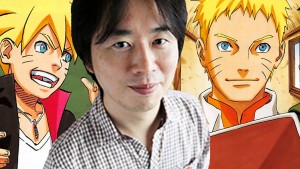
Naruto creator Masashi Kishimoto makes his first-ever appearances outside of Japan in New York Oct. 7-10. (Courtesy of ForeverWorld)
By JQ magazine editor Justin Tedaldi (CIR Kobe-shi, 2001-02) for Examiner.com. Visit his Japanese culture page here for related stories.
The Japan-centric events of the month ahead promise to be as rich and full as autumn itself—brisk and colorful, with a dash of unpredictability.
This month’s highlights include:
Oct. 8-11
Jacob K. Javits Convention Center, 655 West 34th Street
Limited tickets available
The East Coast’s biggest gathering for fans of comics, film, anime and manga, New York Comic Con returns with its biggest roster of Hollywood talent to date, including the first-ever appearance outside of Japan of Naruto creator Masashi Kishimoto, on hand for an exclusive Q&A panel (Oct. 8, 5:30 p.m.) as well as the North American theatrical debut (Oct. 10, 11:30 a.m. at Hammerstein Ballroom) of Boruto: Naruto the Movie! In addition, Kishimoto will also make live appearances at Apple Store SoHo (Oct. 7, 7:00 p.m.), Kinokuniya Book Store (Oct. 9, 8:30 p.m.) and Barnes and Noble Tribeca (Oct. 10, 3:30 p.m.). Don’t miss this chance to meet one of Japan’s most popular contemporary manga artists!
Oct. 9-Jan. 10
For a New World to Come: Experiments in Japanese Art and Photography, 1968-1979 Japan Society Gallery, 333 East 47th Street
$12 students and seniors, $10, Japan Society members. Free on Friday nights, 6:00-9:00 p.m.
In the wake of the social and political upheaval of the late 1960s, Japanese artists and photographers began crafting a new visual language for an age of uncertainty. Their embrace of camera-based experiments would alter the cultural landscape and lay the foundations for contemporary art in Japan. For a New World to Come is the first comprehensive exhibition to spotlight this radical break with the past. With some 200 works by such luminaries as Ishiuchi Miyako, Daidō Moriyama, Jirō Takamatsu, and Shōmei Tōmatsu, the exhibition charts the stunning diversity of photographic practices during this pivotal era, from conceptual series situated squarely within global artistic currents, to visually arresting meditations on time, place, and self.
Oct. 10, 12, 13, 17, 19, 21
Village East Cinema, 181-189 2nd Ave.
$15
See the next generation of Naruto on the big screen! With Naruto as the Seventh Hokage, Hidden Leaf Village is planning to host the Chunin Exams to train new shinobi. Among the entrants are Sasuke’s daughter, Sarada, who adores Naruto, Mitsuki, an exceptionally talented yet mysterious shinobi, and Boruto, Naruto’s son who shows great potential, but despises his father. Sasuke, who’s been on a mission in another dimension, appears before Naruto to warn of a strange impending danger he has sensed. An inconceivable foe lies in wait as Sasuke, the Five Kage, and Boruto charge into another dimension!Presented in Japanese with English subtitles.
For the complete story, click here.
JET alum Bruce Feiler a CNN commentator during Pope’s visit
***************
Bruce Feiler (Tochigi-ken, 1989-90), author of Learning to Bow as well as several books on religion including Walking the Bible, Abraham and Where God Was Born along with other popular books including The Council of Dads, and, most recently, The Secrets of Happy Family, can now add CNN commentator to his resume. He has been providing religion-related perspectives in live conversations with Anderson Cooper, Wolf Blitzer and others.
****************************

To read prior JETwit posts about Bruce Feiler, please click here.
For more regular updates, follow Bruce on Facebook: www.facebook.com/brucefeilerauthor.
And Twitter: www.twitter.com/brucefeiler.
JQ Magazine: Book Review — ‘Starting Point: 1979-1996’ by Hayao Miyazaki
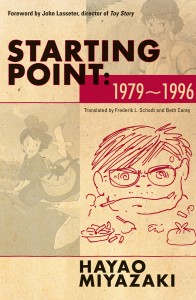
“For those who enjoy the process and precision behind an art, Starting Point is a rare glimpse into an often-times enigmatic industry.” (VIZ Media LLC)
By Alexis Agliano Sanborn (Shimane-ken, 2009-11) for JQ magazine. Alexis is a graduate student of Harvard University’s Regional Studies—East Asia (RSEA) program, and currently works as an executive assistant at Asia Society in New York City.
Starting Point: 1979-1996, translated by Beth Cary and Frederik L. Schodt, is quite unlike its sequel, Turning Point: 1997-2008 (read JQ’s review here). Technical rather than creative, Starting Point shares renowned director Hayao Miyazaki’s recollections of his early days as an animator. The essays and interviews follow anime through production development, touching on the intricacies of character design, layout, and story adaptation. For those who enjoy the process and precision behind an art, Starting Point is a rare glimpse into an often-times enigmatic industry.
The first half of the work features essays on Miyazaki’s long hours in the studio, culture, and nature of Japan’s animation industry in the 1960s and 1970s. As Miyazaki notes, even then, anime was tied to media mix marketing. You didn’t just have manga; you had manga, then an anime, toys, merchandise, and spin-offs all fueling off each other. Says Miyazaki in a 1982 interview: “The world of anime makes its business out of themes like departing for new horizons or love, while pretending not to be conscious of [the] commercial reality.” In hindsight, these remarks prove ironic; the auteur’s Studio Ghibli having similarly succumbed to commercialization.
It isn’t just media mix that remains the same today: professional frustrations were high and work-life balance poor. Miyazaki, over the course of several essays, recounts the life of a young professional. He states: “When young, nearly all of us want to be taken seriously, as soon as possible….In fact, many of those who have not yet taken the plunge into the professional world…tend to speak endlessly about techniques, or concentrate on gaining as much knowledge as possible….In reality, however, once you enter this industry, the techniques required can be mastered very quickly.”
JQ Magazine Editor Interviewed by FCI News on X Japan at Madison Square Garden
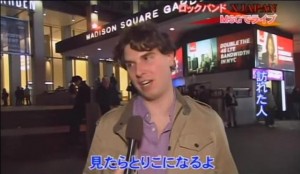
JQ magazine editor Justin Tedaldi talks X Japan outside Madison Square Garden, Oct. 11, 2014. (Courtesy of FCI NY)
JQ magazine editor/Japanese Culture Examiner Justin Tedaldi (CIR Kobe-shi, 2001-02) was recently interviewed by Alex York of Fujisankei (FCI) News for commentary on X Japan’s debut performance at Madison Square Garden on Oct. 11.
The spectacular three-hour show (see JQ‘s review of the concert here) was X Japan’s first and only American concert in four years, and the first to retain the band’s signature full stage production outside of Japan. Check out the video here or click on the image for Justin’s comments, and read his exclusive interview with X Japan’s leader Yoshiki here.
Direct link: http://www.youtube.com/watch?v=yWptyvtYCXM#t=43
Justin’s Japan: Interview with Yoshiki of X Japan on the Band’s Madison Square Garden Debut
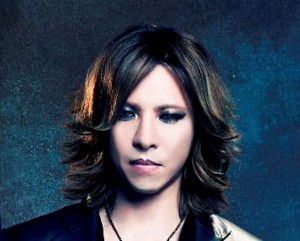
“At an X Japan show, we create a show with the audience—it’s not ‘the band is performing and the audience is just watching,’ so we create the show together. We’re going to try to make Madison Square Garden like a huge club.” (Courtesy of ID PR)
By JQ magazine editor Justin Tedaldi (CIR Kobe-shi, 2001-02) for Examiner.com. Visit his Japanese culture page here for related stories.
For Yoshiki Hayashi, this Saturday (Oct. 11) will go down in J-rock history, as one of the biggest bands in Asia makes their debut at Madison Square Garden. Formed over 30 years ago, X Japan first gained notoriety in the mid-’80s by ushering in the visual kei movement, a style that continues to evolve through other Japanese megastars like L’Arc~en~Ciel (who headlined the World’s Most Famous Arena themselves in 2012).
At the center of it all is X Japan’s founding member, Yoshiki. An equally talented songwriter, heavy metal drummer and classical pianist, he is both the heart and soul of X Japan, and, having lived in Los Angeles for two decades, the ideal mouthpiece for the band’s American tours, which started with a bang in 2010 at Lollapalooza and included a sold-out gig at New York’s now-defunct Roseland Ballroom.
In this exclusive, expansive interview, I spoke with Yoshiki about how the group’s original hopes to play the Garden in 2008 were dashed by personal health and management troubles, his favorite, anime, manga and X Japan songs, and his experience working with legends like Stan Lee, KISS, and the Emperor of Japan.
How did this concert for Madison Square Garden come together? I know there were plans to do this in 2008; can you talk about this history?
Our band reunited around the year 2008. We did our reunion concert in Tokyo Dome, three days or so, I think. At that time, we were also thinking of performing [shows] outside of Japan, and Madison Square Garden was one or two of [the ideas]. But for some reason they didn’t happen, so since then, that venue was always in our minds. A few years ago, we decided to try schedule Madison Square Garden. I think we were kind of confirmed last year.
It’s a long road.
Yes. Well, considering that X Japan was not doing anything—I mean, the band broke up around the end of 1997, so when we reunited we had almost 10 years of a break. We started doing a bunch of arena shows, and then we started touring the world when we went to 16 countries or so. Considering this, the [last] six or seven years have been tours [laughs].
Are there plans for X Japan to play any other concerts for the remainder of the year?
Not now. We just announced our shows in Japan, this place called Yokohama Arena, so we [performed] there Sept. 30 and Oct. 1. It’s kind of like a prelude to Madison Square Garden and a kickoff to [that] show, about 10 days before that. As of now, Madison Square Garden is the only American show, but [depending] on how it goes, we may start another world tour. We’re just talking about it right this moment.
For the complete story, click here.
JQ Magazine: Heisei Nakamura-za Kabuki Returns to NYC This Summer
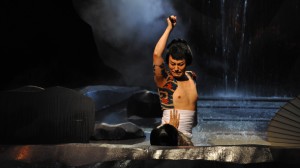
After a seven year absence, Heisei Nakamura-za brings Kabuki to New York’s Lincoln Center Festival July 7-12. (© Shochiku)
By Mark Frey (Kumamoto-ken, 2002-06) for JQ magazine. Mark served as the editor for JETAA Northern California’s Pacific Bridge newsletter from 2007-11, and is currently chapter president as well as coordinator of the JETAANC Kabuki Club.
A warm thought to heat you up as the Fourth of July approaches: real, live Kabuki is coming back to New York City July 7-12 as part of the annual Lincoln Center Festival.
This is great news for Kabuki fans in America. And if you were ever curious about Kabuki, it is a rare chance to see the real thing in your own backyard. The performance is part of a very interesting project called “Heisei Nakamura-za,” which was started about a decade ago by the late, great Kabuki actor Nakamura Kanzaburo, who passed away unexpectedly at age 57 in December 2012.
Kanzaburo wanted to give audiences the chance to experience Kabuki the way it used to be in the “good old days” of the Edo period. Back then, Kabuki was a popular entertainment for the common people. It featured smaller theaters, a more intimate relationship between actor and audience, and a more festive, earthy, raucous feel. So Kanzaburo started constructing temporary theaters in Japan and around the world that reflected this atmosphere. He extended the mood to the plays he staged, putting a contemporary spin on old classics.
In 2012, this reporter was fortunate enough to be able to see Kanzaburo perform in the last Heisei Nakamura-za theater he constructed, in Tokyo’s Asakusa district. It was an unforgettable experience. Some of the best actors of our day were walking a couple feet away from me on the theater’s modest hanamichi runway. A special energy flowed between the actors and the audience that I hadn’t felt at established Kabuki theaters. At the end of the final play, the entire back wall of the theater disappeared and we enjoyed a beautiful, open-air night view of the Sumidagawa River and the newly constructed Skytree Tower. It was a magical evening.
Justin’s Japan: ‘Ghost in the Shell,’ Kishi Bashi, Luna Haruna at AnimeNEXT
By JQ magazine editor Justin Tedaldi (CIR Kobe-shi, 2001-02) for Examiner.com. Visit his Japanese culture page here for related stories.
After an unusually chilly spring, it’s finally starting to feel like summer. Enjoy some seasonal events this month that celebrate the best of both fine art and pop art.
This month’s highlights include:
Wednesday, May 28, 10:00 p.m.
The Bowery Electric, 327 Bowery
$5
An all-female quartet that delivers riff-heavy, post-punk anthems, Each of the Hard Nips came to live in New York at different times, from different parts of Japan. And, as conspired by the ever-dexterous hand of fate, they were to cross paths and become fast friends. They quickly formed a cult-like bond whose rituals all included drinking a lot of alcohol and uncontrollably running their mouths. The wine flowed like Kool-Aid and, somehow, they found themselves buying into the delusion that they were capable of forming a kick-ass rock band. Witness the next chapter in their story, with support from Shakes and the Johnnys.
Thursday, May 29, 7:30 p.m.
Ghost in the Shell: Arise – Borders: 1 & 2
AMC Loews Village 7, 66 Third Avenue
$10
In the first two parts of this highly anticipated prequel series of the anime sensation Ghost in the Shell, it’s the year after the fourth World War and cyborg/hacker Motoko Kusanagi finds herself wrapped up in the investigation of a devastating bombing. But she’s not the only one looking for answers—as she delves deeper into the mystery of who is behind the attack, a specialized team unlike any before begins to take shape.
June 6-8
Garden State Convention Center, 50 Atrium Drive, Somerset, NJ
$45-$60
The largest independently organized anime convention in the New York/New Jersey metropolitan area. AnimeNEXT features Japanese creators of anime and manga, voice actors, musical acts, artists, vendors and exhibits, events, panels, workshops, and gaming. This year’s musical guest is Tokyo’s Luna Haruna, who made her major debut in 2012 with the song “Soraha Takaku Kazeha Utau,” the ending theme song for the second season of anime series Fate/Zero. Her latest single, “Snowdrop,” was featured as the ending theme song the second season of Monogatari. Don’t miss her first-ever performance on the East Coast!
For the complete story, click here.
AJET Professional Development Call with JET alum Anthony Bianchi
On May 7th, we held our fourth AJET Professional Development Conference Call. Our guest speaker was former JET, Mr. Anthony Bianchi (Aichi-ken, Kiyosu City, 1989-91) who now serves as a city council council member in Inuyama City, Aichi prefecture. Mr. Bianchi is often highlighted in the Japanese media and is well-known for being the first American-born elected official in Japan. Click here to read a short interview with him on AJET.net.
Mr. Bianchi discussed the inner workings of his current position, various initiatives to improve English and international communication in his community and how JETs can potentially get involved with local politics in their communities.
Click here to listen to the recording of the call on the AJET website: http://ajet.net/2014/05/13/professional-development-call-anthony-bianchi/
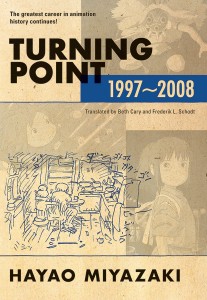
“With wit and humor, Miyazaki offers insight from his long career with every turn of the page. Like an unforgettable sunset or the first time a cooking experiment came out well, he discusses experiences that leave you unexpectedly changed.” (VIZ Media)
By Alexis Agliano Sanborn (Shimane-ken, 2009-11) for JQ magazine. Alexis is a graduate of Harvard University’s Regional Studies—East Asia (RSEA) program, and currently works as an executive assistant at Asia Society in New York City.
I consider myself an aficionado of director and animator Hayao Miyazaki and Studio Ghibli. Having seen his work countless times, visited the museum in Tokyo and done a fair amount of supplemental reading, I figured Turning Point—a collection of Miyazaki interviews and articles spanning 1997 through 2008 and newly translated by Beth Cary and Frederik L. Schodt—would probably be a rehash of the similar. I presumed it would be a book for Japan or anime specialists. On the back cover there’s even a quote from the L.A. Times: “Essential reading for anyone interested in Japanese or Western animation.” However, this statement is entirely too narrow and ultimately misleading.
In fact, the book (which is a sequel to Starting Point: 1979-1996, also translated by Cary and Schodt and now available in paperback) is less about animation and Japan than it is the human condition and those existential questions that keep you awake at night. Miyazaki, at one moment reserved and the other candid, plunges fearlessly into complex, introspective and intellectual issues about human’s relationship with education, child-rearing, philosophy, history, art, environmentalism and war (to name a few).
He does this with a sprinkle of romanticism and a dusting with realism. Using his seemingly continual dissatisfaction with the world, Miyazaki aims to positively spark change and inspire. He insists that his films are not just flights of fancy; rather, he makes them to motivate the next generation to improve the world. “Children learn by experiencing…it is impossible to grow up without being hurt,” he writes. “Experiences like: accepting the duality of human nature, the importance of grit, conviction, and perseverance, and respecting nature and the land….For children willing to start, our films become powerful encouragement.”

